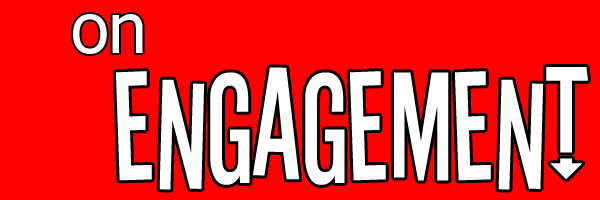
There are various kinds of engagement. People get engaged to one another and call it an engagement. People attack the enemy and that is also called an engagement (as in to engage the enemy). Then social engagements are those black tie affairs. What do they all have in common (yes, all)?
People interacting with each other. Some interact for love, some interact for hate, some interact to put on airs, whatever the reason the engagement usually does not last long. Either they marry, the battle ends, or the band plays the last song of the evening.
Thus to engage means to connect on many levels with others; to be more than just present in the moment. When considering a person engaged, he or she carries one characteristic, whether they admit it or not; they are open-minded. An engaged person has to be open-minded to be fully receptive and understanding of those they engage with. They also expects that same open-mindedness in others. Engagement by the examples I mentioned at the start of this post is a dialogue (of sorts), a two-way interaction.
While one side of the engagement has to take the initiative to get things started it is never fully comes from within. Engagement requires external forces to drive it. Think Newton’s 1st Law: Body is at rest until a force changes that. If a battle is one sided well that’s a good thing (if you are on the winning side) but if in an engagement only one individual wants to marry and the other does not, well that’s creepy and a restraining order may be in order.
Restraining orders notwithstanding, engagement is probably one of the best motivation tool anyone can have to get stuff done. As all parties involved become engaged when each individual or group brings something to the interaction that the other side sees as worthy of engagement. Mutually assured engagement is what completes the interaction and elevates it to a higher level.
This motivation to elevate the engagement and the ability to maintain the engagement until its inevitable conclusion. Motivation to engage is critical for all concerned. Maintaining that motivation is critical to any current and future engagements. The motivation that comes from knowing that at any moment something good is going to happen is the prime factor to motivate most people. It can be catalyst to inspire others to go further and deeper create and achieve others goals when it comes to engaging with others.
The start of the new year is a great time to launch new engagement initiatives. For a long time, people consider the new year as the best time of the year for change as it brings a clean slate to the calendar. The start of the new year is an opportunity to make things better than last year. Yet, engagement does not come without its own issues.
There always have been and always will be barriers to engagement. Time, space, language are such barriers but they are also barriers to just about anything else. When it comes to engagement, the barrier that most will cringe over is the topic or reason of the engagement. When the topic or reason is polarizing to all those participating, the barrier to engagement becomes great especially when others are directly or indirectly affected. The resulting affect of the barrier is either an abrupt end or failure to launch of the engagement. Thus the importance of getting everyone on board before, during and after the engagement is critical.
In the workplace, employee engagement does enhance their own sense of wellbeing. When employees engage they are participating. Leaders, the good ones, know what’s what and not wondering what’s up when they know their employees are engaging and part of what is going on.
While within any organization there individuals that come in all shapes and sizes, there are introverts and extroverts, and all of them focus on the organization’s mission and vision. However, when it comes to engagement, it is essential for management and leadership to understand and accept there is no cookie cutter approach to engagement. So long as everyone understands the message both management and employees must do what it takes to make positive engagement so.
While all employees must engage, the need to understand that there will be individual nuances between the generations (Gen X, Millennials, etc.) is another aspect that can quickly become a barrier or catalyst to positive engagement. Leaders must ensure that all generations within the organization are openly and actively communicating with each other. Dialogue becomes a critical function of opening and maintaining positive and empowering communication among all the members of the organization.
As a leader, it is your duty to help others feel and be more engaged. Any true leader will ensure that all employees are engaging and ready to elevate the level of the current engagement. When followers are not on-board, the primary task of the leader becomes that of getting those followers on-board and actively engaging. A good example of leading by example will go a long way to actively pursuing engagement for those that are having a little trouble getting the picture or getting started with engagement at all levels.